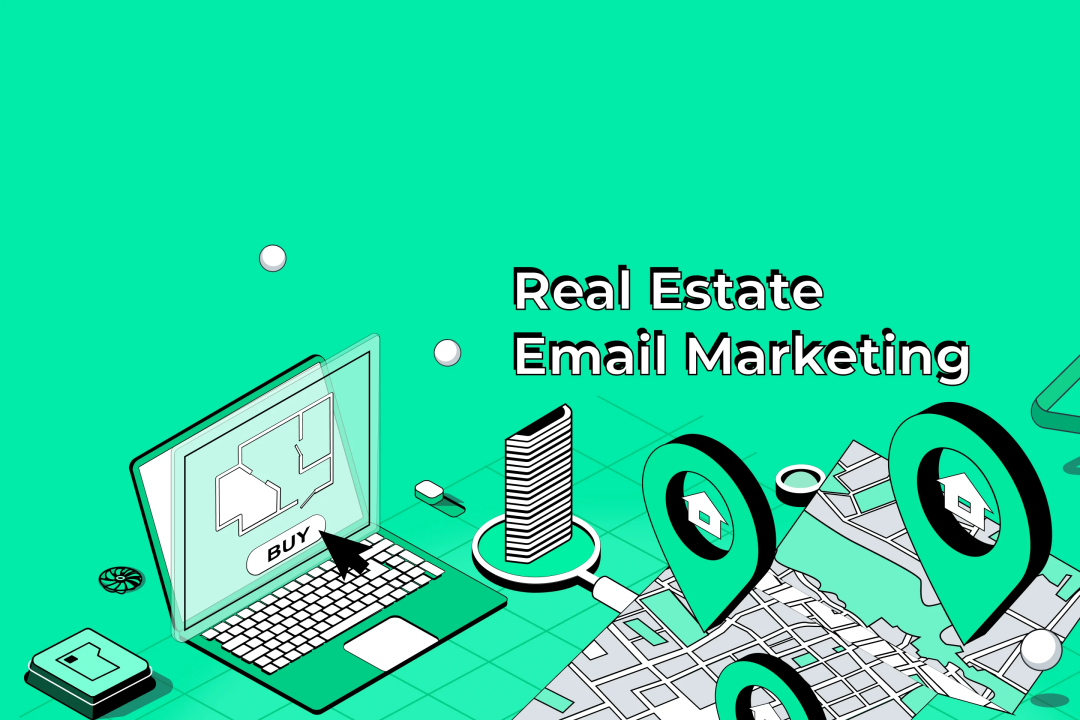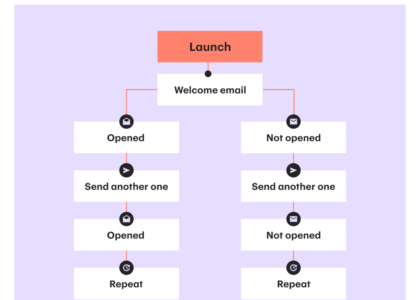So you want to grow your Real Estate business in 2025 with Email Marketing…
Great choice!
Considering how loud and shiny new platforms like TikTok, Snapchat and more are… it is refreshing to know you’re not one of many who think email marketing is dead!
So as a reward for your ability to think outside the box, we’ve created this blog to show you how you can take advantage of the power of email as a marketing tool for your real estate business in 2025.
Email is still one of if not the most effective ways to reach new clients and stay connected with potential buyers or sellers in the real estate industry. The problem is most agents treat email like a digital flyer. “Here’s my new listing. Here’s my open house. Here’s the same newsletter I sent last month.” Then they wonder why no one opens it.
The truth is, email isn’t about blasting. It’s about building relationships, earning trust and providing value. And when you do that well? Your open rate isn’t just a vanity metric, it becomes a lead funnel with serious compounding returns. And don’t just take my word for it, look up the stats on Email ROI because math doesn’t lie. According to the Data & Marketing Association, the average return on investment for email marketing in 2024 is around $36 for every $1 spent. That’s not a typo.
Meanwhile:
- Direct mail sits at about $7–$9 per dollar (and that’s if you’re lucky)
- Cold calling? Costly and time-consuming, with a 1–3% success rate
- Social ads (think Facebook/Instagram): You’re looking at $2–$5 ROI per $1 spent, depending on targeting and creative
Now not only is email cheaper, it’s more personal, trackable, and scalable. You know who clicked. You know what they clicked. You know when to follow up. Unlike social feeds where users scroll past hundreds of posts a day, an email sits there, waiting to be opened, read, and acted upon. Especially when it comes from someone they’ve engaged with before.
YOU ARE IN REAL ESTATE – one of the most relationship-heavy industries out there. Your clients aren’t buying shoes – they’re making life decisions. And guess what? That requires trust.
Email gives you the space to educate without overwhelming. To nurture without nagging. To offer without selling. Whether it’s a weekly “neighborhood market vibe check” or a helpful breakdown of what closing costs actually look like, agents who use email like a conversation, not a campaign will win in 2025.
According to NAR’s 2023 Home Buyers and Sellers Generational Trends report, 73% of recent buyers only interviewed one real estate agent before choosing. That means when you’re in their inbox with value, relevant info, and consistency, you’re likely to be the first and last agent they call.
So while everyone else is trying to go viral on social media or burn cash on cold calls, you could be quietly stacking deals – one email at a time. Your first step to building this legal money printer (because that’s what Email Marketing is) is to build an email list that pays you back!
Building the Right Real Estate Email List (Don’t Just Buy One)
Before you collect emails, know who you’re trying to talk to. Ask yourself: who do I actually want on this list? This process is called “Understanding Your Ideal Buyer or Seller Persona”
- Are they 24-year-olds buying a starter condo?
- Are they parents looking for good schools and big backyards?
- Are they investors who only care about cap rates?
You can’t speak to everyone – and that’s the point. You have to create detailed buyer personas based on demographics, income, property preferences, and lifestyle. Thankfully tools like Google Analytics, Facebook Audience Insights, or even your own CRM can help you identify patterns.
Another smart play is to use your last 5 deals to reverse-engineer what type of person clicks with your vibe. Then build your lead magnets, website content, and social presence for that persona.
Why You Should Not Just Buy A Real Estate Email List
Let’s get this straight… I know some of you are thinking you can buy an email list and get some responses. Yes… that’s Cold Emailing.
However, having a massive list of email contacts won’t help much if nobody on it actually knows you or cares what you have to say. It’s like shouting into a crowded room where no one recognizes your voice. Most people would consider you obnoxious and if there are a good number of offended folk, you’re on your way out!
What you need is a list of real, engaged people who actually want to hear from you. Who want you in the room!
So before you go Googling “buy 10,000 local emails,” let’s be real with you: you can’t shortcut your way to meaningful relationships. Especially not with bots, cold lists, or mystery leads pulled from who-knows-where.
Buying a list is a fast track to poor deliverability, legal risks under CAN-SPAM and GDPR, and a bad reputation with email service providers like Klaviyo or Mailchimp.
According to Mailchimp’s 2023 industry benchmarks, open rates across all industries average around 21.33%, but real estate hovers closer to 19.67%. Now, if you’re blasting out to thousands of uninterested strangers from a purchased list, your open rate could drop below 5%. Worse still, email providers might flag you as spammy – and once you’re on a blacklist, it’s a long road back.
Understand that your list isn’t just a number. It’s people. Families thinking about upgrading, solo renters ready to own, maybe even your neighbor’s cousin who’s been stalking Zillow every night. And those folks? They want relevance, not spam.
So with that said, let’s dive into how you can build a clean, legit, and super-targeted list – without buying anything shady.
How to Ethically Collect Emails From Local Prospects
Real estate is local. Your email list should be too. So how do you find locals who actually want to hear from you? Start where the trust already exists: your local community. People are more likely to engage when the outreach feels familiar, local, and timely. Here are some simple ways to collect emails from your own backyard (legally)
Local Farming: Local farming isn’t about soil – it’s about sowing relationships. Door-knocking is fine if done with tact, but digital farming is where the scale kicks in. Set up neighborhood-specific Facebook groups or Nextdoor forums. Share value-first content, not just listings.
Run localized ads and offer something that speaks directly to your community like downloadable neighborhood guides (including schools, dining spots, and walk scores), and collect emails in exchange. It can be something that provides value like
- “Top 5 Family-Friendly Neighborhoods in Charlotte”
- “2025 First-Time Homebuyer Cheat Sheet – [Your City] Edition”
- “What $350K Buys You in [Zip Code] Right Now”
These aren’t just PDFs – they’re localized hooks that offer value to your own people. Add a form on your website, use a pop-up, or share it in Facebook groups. Another overlooked tactic is the collaboration between realtors and local businesses. You can reach out to local businesses in your area, creating co-branded flyers, discount codes, or giveaway you sponsor that require email opt-ins.
Get creative with this idea for your unique neighborhood, just make sure your offer is gated behind an email input.
Referral Systems & Client Databases
Word of mouth is free and powerful. Data shows that repeat and referral business makes up over 40% of real estate transactions for agents with 3+ years of experience. That’s not something to sleep on.
If you’ve closed deals before, you’ve already got a goldmine. Ask past clients if you can add them to your newsletter or market update list. Don’t just hope clients will talk about you – ask them to and in fact, offer referral bonuses (where allowed by law) or loyalty perks like home maintenance reminders, birthday messages, or exclusive content.
Don’t wait for them to come to you. Send value-packed updates like neighborhood news, home care tips, or tax-time property deduction reminders. Your database shouldn’t feel like a cold file drawer – it should feel like a living, breathing relationship hub.
How to Ethically Collect Emails From Open Houses, IDX Sites & Social Media
You’re already meeting people for showings and stuff – might as well make the most of it.
It’s time to get creative with where and how those people you meet actually drop their email.
Open Houses: In 2025, you have to look beyond open houses as being just about showing homes and start looking at open houses as lead goldmines. If you’re still using the old paper sign-in sheets, news flash it’s time to evolve Use a digital kiosk or tablet with a clean sign-up form. Your sign up form can include a section where you ask for their preferred neighborhoods or home types. This helps segment your list later and send targeted campaigns. So next time you’re at an open house:
- Use a tablet at the door with a branded sign-in form (no paper -too easy to lose or misread).
- Incentivize it: “Enter to win a $50 local restaurant gift card – just drop your email.”
- Follow up with “Thanks for coming” messages and personalized recommendations based on what they liked.
IDX (Internet Data Exchange) website: These platforms already offer property search tools, but many agents underutilize their lead capture features. Set up alerts for saved searches, but gate them behind an email opt-in. And please stop sending those boring “Join our newsletter” lines. Try saying something like “Get price-drop alerts for homes in your dream neighborhood”. Other options you can use are;
- Set property alerts as opt-ins. “Want to be the first to know when a 3BR under $400K hits the market?”
- Add exit-intent popups offering curated lists (like “Condos near downtown with free parking”).
Turn Social Media into Lead Gen Machines: Don’t just post pretty listings. Use Facebook Lead Ads or Instagram Story polls to drive traffic to landing pages with freebies like a “10-Step First-Time Homebuyer Guide” or “Top 5 Renovations That Add Value Fast.” Make it simple and friction-free to sign up.
- Create carousel posts with neighborhood stats, then invite people to “Get the full market report—just drop your email.”
- Pin a post with a freebie offer or set up a Linktree-style landing page with multiple lead magnets.
And that’s how you build your real estate email list ethically.
Now if you notice, this email acquisition strategy relies on exchanging something valuable and value-packed also known as a lead magnet for your prospects email. Not all lead magnets are created the same – and while some will have your prospects going “meh, I guess I’ll give you my email” , others will have them going “Holy smokes! I would have paid for that!”
So to save you a lot of time, money and testing-the-waters headache, we have written this section on lead magnets that Real Estate clients actually want.
Let’s get into it!
Lead Magnets That Real Estate Clients Actually Want in 2025
Real estate leads are way savvier now in 2025
Your leads are not waking up excited to download your 37-page generic home-buying eBook. Whether someone’s just peeking at listings or fully ready to move, they’re expecting real value in exchange for their email. So if your goal is to turn that random scroll into a solid lead, you’ve gotta give them something they actually care about.
We’ve done the homework to show you what works in the real estate industry in 2025.
Now, before you can design an irresistible lead magnet, you gotta understand the mindset of your audience. Zillow, NAR (National Association of Realtors), and even Redfin have been tracking what consumers search for, click on, and interact with. And spoiler alert it’s not your templated PDF titled “Guide to Buying a Home.”
According to a 2023 Zillow Consumer Housing Trends Report, 72% of buyers want tools that help them better understand the process, and 58% feel overwhelmed at the start of their home search. So what kind of resources get them to stop, click, and engage?
Market Reports (Localized, not nationwide)
Homebuyers and sellers have a lot of questions swirling in their heads. Most people love seeing what homes are going for in their neighborhood. These reports answer the “Is now a good time to buy or sell in my neighborhood?” question.
Here’s what works in 2025:
- “What’s My Neighborhood Worth in April 2025?”
- “3 Trends in [Your Zip Code] That Might Surprise You”
- Note: You can make your market report interactive or pull live data (like from MLS or Redfin APIs).
Home Valuation Tools
You’ve seen the “What’s My Home Worth?” tools before. These are lead magnets that feel personal and accurate. Thing is, they still work because 8 in 10 homeowners are casually curious about their home’s value – even if they’re not actively selling.
Here’s what works in 2025:
- Embed a smart estimator on your landing page using tools like Homebot or Cloud CMA
- Include email capture after showing partial results – this increases conversions by up to 30%
Homebuyer or Seller Checklists (But Done Right)
Think of these like the Buzzfeed quizzes of real estate. People don’t want to miss a step, and they love a good list.
Instead of boring:
- “10 Things Nobody Tells You About Buying Your First Home”
- “The Ultimate 2025 First-Time Buyer Gameplan”
- “Are You Move-Out Ready? Take the Checklist Challenge”
Put them in Google Docs or Notion-style templates so they feel modern and easy to use.
Now that you know what lead magnets are working for real estate businesses in 2025, it is important to note that even the best lead magnet in the world won’t do much if visitors don’t want to give you their info to get it. That’s where most agents drop the ball.
A killer checklist, guide, or home valuation tool is only half the battle. The real magic happens when your opt-in form is just as compelling as your freebie. It’s the handshake before the relationship starts – and if that first impression feels clunky, confusing, or outdated, potential leads will bounce faster than a fraudulent check.
To help you get a head start, we’ll teach you how to create opt-in forms that convert as well as how you can create an offer for different types of leads. Let’s dive in.
Creating Opt-In Forms That Actually Convert in 2025
Most real estate websites and social media platforms have invisible opt-ins or worse – ignored opt-ins. An amazing lead magnet with a boring opt-in form is like hiding candy in a locked drawer. No one’s getting in.
So let’s explore what actually works, based on A/B testing across over 100 real estate websites (thanks, Unbounce and Sumo for the data):
- Forms with 2-3 fields convert best – That’s right… just asking for their name and email usually does it.
- Placement matters – Pop-ups timed to scroll (at 35–45% page view) get more engagement than immediate ones. Sidebar and mid-blog CTA boxes also outperform footers by 62%.
- Buttons should talk like people – “Get the Checklist” beats “Submit” by a landslide. And yes – CTA buttons that echo the offer convert 45% more. So if the lead magnet is a homebuyer checklist, don’t say “Join,” say “Send Me the Checklist.”
Now when you’ve created a form based on these recommendations, put that same form everywhere. Your homepage. Your blog posts. Your bio link on Instagram. Your Facebook business page. Embed it like your business depends on it – because it kinda does.
With that said, it’s important to understand that a good lead magnet and a great opt-in form is an amazing combination but for maximum conversions, your lead magnet and opt-in form has to be offered to the right type of lead at the right time in their buying cycle. So let’s look at how we can create an offer that works for different type of leads at different points in their buying cycle.
How to Create an Offer That Works for Both Hot and Cold Leads
Not everyone’s ready to buy tomorrow – and that’s okay. That also doesn’t mean they won’t convert later – which is why your lead magnets should have a warm-up funnel baked in. Everyone needs something different so while some leads need to be educated, others need reassurance. And if you give people something that feels tailored, timely, and genuinely useful, they’ll not only give you their email… they’ll remember you when they’re finally ready to move.
Here’s a quick breakdown of what that means for your real estate business:
| Lead Type | What They Need | Ideal Freebie |
|---|---|---|
| Cold (Just browsing) | Clarity + curiosity | “Homebuying 101: 5 Myths That Cost People Money” |
| Warm (Thinking seriously) | Validation + guidance | “This Month’s Market Snapshot for [City]” |
| Hot (Ready to act) | Tools + actionables | “Book a Free 15-Minute Buyer Strategy Call” |
One thing we always recommend to our clients here at Abervin Digital is that they mix lead magnets with automated email sequences. For example, someone grabs your “Seller Checklist” – they should get a short 3-part email series afterward:
- “What to Expect in Your First Week on the Market”
- “The #1 Thing That Lowers Home Sale Price”
- “Want a Custom Price Estimate? Let’s Chat”
This nurtures them from interest to intent – without you needing to chase anyone.
All this talk of setting up email series has us excited to close off this blog with a detailed explanation of what we mean when we say you can nurture your real estate prospects without needing to chase anyone. And the way to do that is with automated email flows. Think of this as your passive income source.
Let’s dive into the email flows that every Real Estate Business should automate in 2025
The Must-Have Automated Email Flows for Real Estate Businesses in 2025
Your leads are ghosting you not because they’re not interested, but because your follow-up game is slower than a dial-up connection.
Real Estate is all about timing, trust, and staying top-of-mind. But you can’t be in a thousand places at once, and you definitely don’t have time to chase every lead manually. That’s where email flows come in.
If you’re in real estate and you’re not using automated email sequences yet, you’re leaving serious money and momentum on the table. So, let’s break down the six essential email flows every real estate business should automate – and why each one is a must if you’re looking to scale without burning out.
1. Buyer Welcome Series – First Impressions Matter, A Lot
According to the National Association of Realtors (NAR), 41% of buyers begin their home search by looking online, but they often don’t commit to a specific agent right away. When someone signs up on your website, downloads your guide, or clicks through to your listings, that’s your window to say “Hi, I’ve got you.” But if you wait even 24 hours, the momentum cools.
Stats show that companies that respond within an hour are 7x more likely to have a meaningful conversation with a lead. Unfortunately most agents wait at least a day. An automated welcome flow turns that “Hey, I’m curious” into “Hey, I trust you”
What your buyer welcome series should include:
- Email 1: A super chill welcome that sets expectations. Example: “Thanks for checking out listings with me. Here’s what you’ll get moving forward.”
- Email 2: A quick-start guide like “5 Mistakes First-Time Buyers Make in [Your City]”
- Email 3: A mini intro to your team or how you work (this builds trust fast)
- Email 4: Testimonials or short case studies with real buyer wins
- Email 5: Optional invite to schedule a chat or tour
Space these over 10–14 days. Use first-name personalization, and test subject lines that lean friendly but specific (“Hey Jordan, still eyeing that downtown loft?” outperforms “Real Estate Updates”).
2. Seller Nurture Flow – Educate Before You Pitch
Sellers are more cautious than buyers… after all, they’re handing over their most valuable asset. Homeowners thinking of selling usually sit on that decision for weeks or even months. You want to be the name they trust by the time they finally pull the trigger. The NAR reports that 63% of sellers only interview one agent. Your nurture flow is what makes sure it’s you.
What your seller nurture flow should include:
- Email 1: A warm welcome + a mini checklist to prep their home for a future sale
- Email 2: Data snapshot: “Here’s what homes like yours are going for in [their zip code]”
- Email 3: Behind-the-scenes breakdown: “What really happens once your home is listed”
- Email 4: Seller testimonials or video clips showing your process in action
- Email 5: CTA for a free valuation or pre-listing strategy session
This flow should not feel like a pushy sales pitch. You want it to be educational, honest, and chill – like a friend who knows the market inside and out. Use dynamic content to customize the market stats to their area. If you know their zip code, you can use localized content to boost open rates by up to 29%, according to Campaign Monitor.
3. Cold Lead Reactivation – Wake Up the Ghosts
Every real estate CRM is haunted by leads who ghosted after a showing, opened your newsletter 7 times but never replied, or downloaded your home buying guide and then vanished. But people don’t go cold for no reason – they usually get overwhelmed or distracted. And when they’re ready again? They will work with the agent who reappears at just the right time.
What your cold lead reactivation series should include:
- Email 1: A casual check-in. “Hey – still exploring the idea of buying? Totally okay if timelines changed. Just wanted to say hi.”
- Email 2: Something valuable like “Here’s what’s trending in [city] this month” or “5 new listings under $500K”
- Email 3: A “What’s your status?” email with 3 buttons: “Still searching,” “Paused for now,” “Already bought”
- Email 4 (optional): Invite them to reconnect with you personally – maybe a virtual coffee chat
Use this sequence for anyone who hasn’t opened or clicked in 60–90 days. Your goal here is re-engagement, not a hard conversion. Show them you remember who they are and why they reached out in the first place.
4. Open House Follow-Up – Don’t Let Interest Fizzle Out
Someone came to your open house or private showing? That means they carved time out of their weekend to potentially find “the one.” That’s as warm as leads get. According to ShowingTime data, buyers decide within 5–10 seconds if a home is right—so your follow-up needs to hit while they’re still visualizing their furniture in the space. But 80% of the time, agents don’t follow up within 24 hours. That’s a huge missed opportunity.
What your open house follow-up email series should include:
- Email 1 (same day): A thank-you note, photo recap of the property, and quick link to your contact info.
- Email 2 (within 48 hrs): “Liked that place? Here are 3 similar homes you might vibe with.” Include new listings or comparable comps.
- Email 3 (3–4 days later): A soft nudge: “Curious how long homes like that one stay on the market? Let’s talk strategy.”
A smart play for real estate businesses is to use behavioral triggers to create a follow up. If they click a specific property link, follow up with more homes in that price range or neighborhood. Platforms like Follow Up Boss and Real Geeks make this possible without lifting a finger.
5. Post-Closing Follow-Up – Reviews, Referrals, and Relationships
According to BrightLocal, 91% of consumers trust reviews as much as a personal recommendation. And NAR says more than 60% of clients found their agent through a friend, family member, or coworker. But here’s the kicker – most agents never ask for referrals. Automation fixes that. After the deal is done, smart agents know that post-closing contact leads to reviews, referrals, and repeat business.
What your post-closing follow up series should include:
- Email 1 (7 days post-close): “Congrats on the new place! If you’re loving the experience so far, would you mind sharing a quick review?” Include direct links to Google, Zillow, or Realtor.com
- Email 2 (1 month post-close): “Have any friends looking to buy or sell? Referrals mean the world to me.”
- Email 3 (3 months later): Homeowner tips + subtle referral reminder
- Email 4 (anniversary of close): “One year in! How’s the home treating you?” Add a gift or incentive if you’re running a referral promo
Use these emails to stay top-of-mind. Most people won’t move again for 5–7 years, but they will refer someone in the meantime. Tools like Zapier or Homebot can send this flow based on your CRM’s closing date – no manual follow-up needed.
Alright, that’s everything. If you made it this far, you’re clearly not just dabbling – you’re looking to actually do something smart with email marketing, and that’s kind of a big deal.
The truth is, real estate isn’t just about listings and lockboxes anymore. If you want to grow in 2025, your email game needs to be strong. That’s where we come in. At Abervin Digital, we help agents like you turn inboxes into booked appointments and browsers into serious buyers.
If you’re ready to take the next step – or just want to talk through your ideas hit us up at +1 307-271-5184 or check out our pricing and packages at Abervin Digital. We’d love to help you build something that turn email into one of your highest-performing marketing channels.






